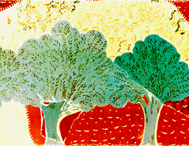
Ancient Egypt
ORGANIZED PRODUCTION
Approximately 5,000 years ago, olive oil was produced on a regular basis in Egypt, Phoenicia, Anatolia, Palestine and, later, on Crete. The latter, a mountainous island, covered by forest, was one of the most powerful states in the Mediterranean. Its economy prospered, initially with the extraction of wood, evolving to increasing cultivation of beans, peas, lentils, lettuce, vines and olive trees.
In time, the olive became a more important fruit than the grape. The olive trees assumed such importance for the island that the first documents (Mycenaean tablets) that spoke of olive trees were found on Crete, dating back to the Minos kingdom, 3,500 years ago. The most ancient representations related to olive trees are the frescos of that time, which are also found on the walls of the Knossos Palace, on Crete. Today, these paintings are to be found in the Heraklion Archaeological Museum.
The fact is that, at the end of the third millennium, the Minoans already used olive oil as fuel for their lamps; in the absence of soap, used it to clean their bodies; and olive oil formed the bases for perfumes; as well as acted as a powerful ointment. Furthermore, as a medicine, in the História da Medicina, page 63, Leon and Petrucelli say that olive oil was, apparently, the main balsam for open wounds, probably to prevent the adherence of bandages covering them. To us, this affirmation seems rather narrow, as olive oil acts also as an excellent insulator, preventing lesions from being exposed to contact with harmful airborne agents.
So great were the beliefs regarding olive oil that even Aristotle, disciple of Plato, mentor of Alexander the Great and master in logic, believer in the divine powers of olive oil, anointed himself with it before meetings with his disciples. He believed that, in this manner, he would never lack knowledge and self-confidence during debates. The book, História da Alimentação (Jean-Louis Flandrin and Massimo Mantanari), cites historical documents, dated around the 20th century B.C., referring to the Persians and Sumarians, their great banquets, commemorative parties, birthdays and rituals in honour of their gods. The various condiments, foods and drink consumed in these events are described, and it is interesting that olive oil is the common denominator appearing in all these types of events, not to season or prepare some sort of dish, but to enhance hairstyles, giving a sheen to the hair. It happens that, in that period, with very rare exceptions, and unlike the olives, the oil was used only as an ingredient in bread making. There are several references to olive oil as a medicine, as an ointment, a fuel, a preservative, a substitute for soap, skin protection against the cold, a cosmetic for skin elasticity, a base for perfume, but, until then, in no text did olive oil appear as a seasoning to be ingested in its natural state.
In time, the olive became a more important fruit than the grape. The olive trees assumed such importance for the island that the first documents (Mycenaean tablets) that spoke of olive trees were found on Crete, dating back to the Minos kingdom, 3,500 years ago. The most ancient representations related to olive trees are the frescos of that time, which are also found on the walls of the Knossos Palace, on Crete. Today, these paintings are to be found in the Heraklion Archaeological Museum.
The fact is that, at the end of the third millennium, the Minoans already used olive oil as fuel for their lamps; in the absence of soap, used it to clean their bodies; and olive oil formed the bases for perfumes; as well as acted as a powerful ointment. Furthermore, as a medicine, in the História da Medicina, page 63, Leon and Petrucelli say that olive oil was, apparently, the main balsam for open wounds, probably to prevent the adherence of bandages covering them. To us, this affirmation seems rather narrow, as olive oil acts also as an excellent insulator, preventing lesions from being exposed to contact with harmful airborne agents.
So great were the beliefs regarding olive oil that even Aristotle, disciple of Plato, mentor of Alexander the Great and master in logic, believer in the divine powers of olive oil, anointed himself with it before meetings with his disciples. He believed that, in this manner, he would never lack knowledge and self-confidence during debates. The book, História da Alimentação (Jean-Louis Flandrin and Massimo Mantanari), cites historical documents, dated around the 20th century B.C., referring to the Persians and Sumarians, their great banquets, commemorative parties, birthdays and rituals in honour of their gods. The various condiments, foods and drink consumed in these events are described, and it is interesting that olive oil is the common denominator appearing in all these types of events, not to season or prepare some sort of dish, but to enhance hairstyles, giving a sheen to the hair. It happens that, in that period, with very rare exceptions, and unlike the olives, the oil was used only as an ingredient in bread making. There are several references to olive oil as a medicine, as an ointment, a fuel, a preservative, a substitute for soap, skin protection against the cold, a cosmetic for skin elasticity, a base for perfume, but, until then, in no text did olive oil appear as a seasoning to be ingested in its natural state.

AN IMPORTANT PRODUCT FROM CRETE
Olive oil was an important merchandise for Cretan trade, the olive tree, olives and their oil being treated as a form of wealth, involving known planting methods, harvesting and production: the cultivation implied furrowing the stony soil of the island with a two-pronged plough, and using an irrigation system with ditches and canals. After five years, the trees reached production age, and at 20, their most productive period was attained. The harvest was conducted in a simple manner, beating the trees with poles, and then raking to gather up the fallen olives (in many European regions this process remains unchanged).
The fruits were soaked in hot water, crushed and placed in barrels of water. When the oil rose to the surface, the water was drained to leave the oil. To cook or season their food, the tendency of the ancient peoples was to use various types of animal fat: pork fat, that from cows, geese and other fowl; besides vegetable oils: sesame, walnut, linseed and castor. However, even though olive oil was not used to prepare their dishes, the Egyptians possessed knowledge of the preserving power of this golden liquid. The proof of this is that the great pharaohs were embalmed and anointed with olive oil, so that not only their spirits but also their bodies would travel the long path to eternity in the best possible state of preservation. When the tomb of pharaoh, Tutankamon was discovered in 1922 (as recently as the mid-XX century), the atmosphere was still scented with the aroma of the olive oil used in his embalmment. Alkalies and olive oil were the ingredients in the formula for the soap used by the Egyptians.

Still in Leviticus 8,10: And Moses took the anointing oil, and anointed the tabernacle, and all the things that were in it, and sanctified them. And he sprinkled some of it on the altar seven times, and anointed the altar and all its vessels, and the laver and its base, to sanctify them. And he poured some of the anointing oil on Aaron's head, and anointed him to sanctify him. Then Moses brought the sons of Aaron, and clothed them with tunics, and girded them with belts, and adjusted their tiaras, as Jehovah had commanded Moses.
The Spanish called the olive oil lampante, as they burnt it in lamps just as mentioned in the Bible: Command the Israelites to bring you clear oil of pressed olives for the light so that the lamps may be kept burning... (Exodus 27:20) Myrrh, cinnamon, sweetflag (Acorus calamus), senna (Cassia spp.) and olive oil. In Exodus 30:22 - 30:28, the sacred oil of sanctification of the Jewish rituals is constituted thus: the Lord also said to Moses: Take the following fine spices: 500 shekels of liquid myrrh, half as much (that is, 250 shekels) of fragrant cinnamon, 250 shekels of fragrant cane, 500 shekels of cassia?all according to the sanctuary shekel?and a hin of olive oil. Make these into a sacred anointing oil, a fragrant blend, the work of a perfumer. It will be the sacred anointing oil. Then use it to anoint the Tent of Meeting, the ark of the Testimony, the table and all its articles, the lampstand and its accessories, the altar of incense, the altar of burnt offering and all its utensils, and the basin with its stand. You shall consecrate them so they will be most holy, and whatever touches them will be holy. Siclo- 11,7 g / Him-3,15
The fruits were soaked in hot water, crushed and placed in barrels of water. When the oil rose to the surface, the water was drained to leave the oil. To cook or season their food, the tendency of the ancient peoples was to use various types of animal fat: pork fat, that from cows, geese and other fowl; besides vegetable oils: sesame, walnut, linseed and castor. However, even though olive oil was not used to prepare their dishes, the Egyptians possessed knowledge of the preserving power of this golden liquid. The proof of this is that the great pharaohs were embalmed and anointed with olive oil, so that not only their spirits but also their bodies would travel the long path to eternity in the best possible state of preservation. When the tomb of pharaoh, Tutankamon was discovered in 1922 (as recently as the mid-XX century), the atmosphere was still scented with the aroma of the olive oil used in his embalmment. Alkalies and olive oil were the ingredients in the formula for the soap used by the Egyptians.

OLIVE OIL AND MOSES
The LORD said to Moses, "Tell the Israelites to bring me an offering. You are to receive the offering for me from each man whose heart prompts him to give. These are the offerings you are to receive from them: gold, silver and bronze; blue, purple and scarlet yarn and fine linen; goat hair; ram skins dyed red and hides of sea cows; acacia wood; olive oil for the light; spices for the anointing oil and for the fragrant incense; and onyx stones and other gems to be mounted on the ephod and breastpiece. (Exodus 25:1 - 25:7) Since the primordial beginnings, olive oil has been present in the Jewish rituals. The Lord called Moses and said to him: DISCREPÂNCIA: When someone makes an offering of cereals to the Lord, his offering shall be flower# of flour. In it shall lie olive oil, and on it incense shall be put...? (Leviticus 25,1/7)Still in Leviticus 8,10: And Moses took the anointing oil, and anointed the tabernacle, and all the things that were in it, and sanctified them. And he sprinkled some of it on the altar seven times, and anointed the altar and all its vessels, and the laver and its base, to sanctify them. And he poured some of the anointing oil on Aaron's head, and anointed him to sanctify him. Then Moses brought the sons of Aaron, and clothed them with tunics, and girded them with belts, and adjusted their tiaras, as Jehovah had commanded Moses.
The Spanish called the olive oil lampante, as they burnt it in lamps just as mentioned in the Bible: Command the Israelites to bring you clear oil of pressed olives for the light so that the lamps may be kept burning... (Exodus 27:20) Myrrh, cinnamon, sweetflag (Acorus calamus), senna (Cassia spp.) and olive oil. In Exodus 30:22 - 30:28, the sacred oil of sanctification of the Jewish rituals is constituted thus: the Lord also said to Moses: Take the following fine spices: 500 shekels of liquid myrrh, half as much (that is, 250 shekels) of fragrant cinnamon, 250 shekels of fragrant cane, 500 shekels of cassia?all according to the sanctuary shekel?and a hin of olive oil. Make these into a sacred anointing oil, a fragrant blend, the work of a perfumer. It will be the sacred anointing oil. Then use it to anoint the Tent of Meeting, the ark of the Testimony, the table and all its articles, the lampstand and its accessories, the altar of incense, the altar of burnt offering and all its utensils, and the basin with its stand. You shall consecrate them so they will be most holy, and whatever touches them will be holy. Siclo- 11,7 g / Him-3,15
